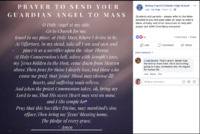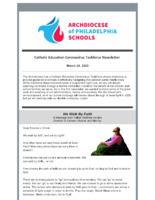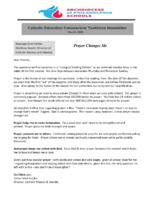The Blessings of Technology in Catholic High Schools
By Nastassya Ferns
For students, teachers, and religious leaders, the utilization of various digital tools during COVID-19 became imperative to maintaining a sense of normality in a faith-based, educational setting. From Facebook sermons delivered to homes worldwide, to the migration of classrooms online, to email newsletter updates sent daily to quarantined families, new forms of digital engagement emerged within the Catholic high school community at the onset of COVID closures. The Blessings of Technology in Catholic High Schools urges us to consider the implications of maintaining faith during COVID-19, and how these schools utilize and adapt to a newly-constructed educational landscape.
Between May and June of 2020, 48 digital items were collected from various Catholic High Schools in Pennsylvania. These items, which include text documents, photos, emails, drawings, movies, social media messages, and memes were then coded and analyzed for recurring themes. Using nine key documents from Allentown Central Catholic High School, Bethlehem Catholic High School, Bishop Carroll Catholic High School, and the Archdiocese of Philadelphia Schools, The Blessings of Technology project examines the digital interplay between students, families, educators, and religious leaders. Throughout this examination, I pose the question: What does it mean to combine faith, education, and technology?
Facebook Live Mass: Tech Blessings
During March of 2020, Pennsylvania schools began to announce closures due to the pandemic. In response to government policy, Catholic high schools across the state urged parents, students, and educators to abide by social distancing policies. With educational and worship routines disrupted, communities scrambled to adapt their routines to an online environment.
On March 24, Father Mark Searles of Allentown Central Catholic High School released the first of what was to be many Facebook video messages. Dressed in his chasuble, Fr. Searles speaks in front of a traditional Catholic altar - giving his audience visual clues that religious rituals such as Mass will be maintained in an online setting.
As an introduction to his online masses, Fr. Searles utilizes what appears to be a video application to transmit a message to the Allentown Central community. He touches on themes of love and other positive sentiments, encouraging the community to stay healthy and maintain their faith through prayer.
"I'll be offering my mass today for all of you and for your intentions. And tomorrow on the solemnity of the annunciation - a big day tomorrow, a day that we were scheduled to have a school mass. I'm going to try to do a Facebook live mass here in our chapel for you all. So maybe tomorrow, which would be Wednesday, March 25th to nine around noon. I'll try to get something up and going so we can pray together. But again, just wanted to say that we love you. We're praying for you. Stay well, and keep working hard and praying even harder. God bless you, Central Catholic."
A few weeks later, Fr. Searles released another poignant message via Facebook. Themes of encouragement appear again, reassuring viewers that although they may not be united in a physical space, maintaining faith through prayer is necessary. Additionally, he also noted:
"Whether you need some online, one on one meetings with the counseling or, or campus ministry offices with guidance, we're here to help you and to pray with you and to support you, whatever you need, as well as we encourage you to stay in touch with your teachers and peers, with the blessings of technology, to continue to develop and to be your best selves."
For many who suddenly found themselves without a classroom nor house of worship to visit in person, religious and educational leaders were tasked with the responsibility of maintaining routine through online communications. As a central component of Catholic religious life, both live and video recordings of masses were established as an alternative to in-person worship. As Fr. Searles remarked, "with the blessings of technology," the students who found themselves without in-person guidance were encouraged to remain faithful and be their best selves through the use of digital means.
Go to God: Prayer and Faith through Internet Resources
Utilizing tools like Facebook, Google, and YouTube became necessary to transmit a sense of faith within Pennsylvania Catholic High Schools during COVID-19. Early on in the school closures (March 22th,) the Bishop Carroll Catholic High School Facebook page directed their community to consult a school email blast, which details how to attend virtual mass and other resources “to help with prayer.” Of note, a commenter on the post praises Bishop Carroll for their digital response, noting that social distancing requirements are not being implemented by their respective bishop, who “has no regard for human life.”
A few days later, The Archdiocese of Philadelphia Schools released a newsletter to the Catholic Educational community that details a change of worship habits during the pandemic, and encouraged individuals to stay connected to their faith through the use of prayer resources. In this newsletter, Fr. Guckin reflects on the ability to “go” to religious tools (including social media,) emphasizing that one can choose to be tempted by “destructive action,” or maintain faith by going to God. With an emphasis on scheduling time for daily prayer and worship, he emphasizes that Mass can be watched on television or online.
“There are so many places to "go" during times of uncertainty. We can 'go' to social media. We can 'go' to our family and friends. We can choose to go to some destructive action. The person who chooses to walk by faith goes to God. I recommend you set up a schedule of daily prayer in order to do this. Pray the rosary. Watch Mass online or television. Make a holy hour. Go to God!”
In a later edition of the Archdiocese Coronavirus Taskforce Newsletter, Fr. Gucklin returns to the theme of resisting temptation and urges the community to pray instead, which will offer the individual a sense of strength and peace. While Coronavirus is not mentioned specifically, he notes that “prayer allows me to be spiritually connected even when we’re socially distanced,” (emphasis mine.) In absence of in-person gatherings, Father Matt Guckin encourages Catholic community members to seek out a faith connection through the use of internet tools. While prayer is something that “we tend to keep private,” he advises that "YouTube has more than 23 million videos on prayer," “Amazon offers more than 100,000 books on prayer,” and Google returned more than "800 MILLION web pages devoted to prayer." Fr. Gucklin ends his newsletter with the importance of staying united with God through available technology.
“Given just how popular prayer - with books and videos and web pages; given all prayer does for me - regarding temptation and staying united with God and others; given ALL this, the only question I'm left with is this - why don't I do it more often?”
Zoom Classrooms
With community faith and worship shifting to an online environment, educational resources were needed to be adapted to a digital space as well. Much of my collected data revolved around the transition from in-person instruction to distance learning, with many religious leaders and administrators emphasizing a sense of gratitude toward the teachers and school personnel who had worked so hard to make the shift.
“As you know, Gov. Wolf has extended the Stay-at-Home indefinitely. It is so disappointing for us all, but we will continue to be together in our virtual world.”
Yet, she remains optimistic, despite the stay-at-home orders. She acknowledges the charitable actions of companies who provide resources to students and families, which aid with the negative effects of social distancing. She remarks that the “connection” between individuals was an important aspect of the Zoom meeting, in addition to discussing technical issues.
"Not only are the students learning, but our teachers, staff, and administrators are discovering new sources of information and platforms by which to deliver their lessons. As a group, we were able to hold a faculty meeting via Zoom. It was so nice to hear how the first lessons went. We shared screens in order to share tips with one another. We watched Mr. Kelly juggle his baby while attending the meeting, and we laughed together. As important as the information sharing was, the connection was just as important."
The Archdiocese of Philadelphia Schools Coronavirus Taskforce Newsletter from March 24th emphasized this connection, and included pictures of teachers in the community utilizing technology for a variety of instructional purposes, including algebra lessons, Spanish, and choir practice. The newsletter commented that, “using tools like Google Suite, Google Hangout, ZOOM, Screencastify, and Loom, teachers reimagine how instruction can be rigorous, interactive, personal, and immediate each day for their students who would be attending school from the safety of their own homes.”
In a later letter to Bethlehem Catholic High School, Principal DeNofa mentions that "the teachers continue to hone their technological and teaching skills in this remote learning environment with weekly faculty meetings and training," detailing utilities such as “LMS pages,” and a “global calendar function,” which help with educational workflow. She again acknowledges the difficulties in the transition, but assures the students and parents that teachers are available to help with “content or technical issues.”
Finally, Principal DeNofa expresses gratitude to parents for keeping children “on track,” and to take care of themselves outside of mandatory academic activities. Touching on themes of reassurance and positivity, she encourages everyone to “please take advantage of the many resources available online to take care of yourself and your families. We will get through this together.” She ends the letter with the following:
“Most especially, PRAY, pray for an end to this pandemic, pray for those who are sick, pray for those who have died, pray for caregivers…pray for all. Take advantage of all the Liturgies that are available online…celebrate with the Bishop, your parish or church, a parish in a different part of the country, pray for our common world…just PRAY!”
Like prior examples from Frs. Searles and Guckin, Principal DeNofa urges the community to take advantage of digital resources to maintain faith. However, she takes on a particularly commanding tone in this letter, directing individuals to “just PRAY!”, no matter how they see fit.
Conclusion
Within Pennsylvania Catholic High Schools observed in this project, the COVID-19 pandemic spurred on a variety of new challenges for the community. Without in-person worship services, classes, or guidance, leaders were tasked with how to provide a digitally interactive routine that encompassed faith and educational rigor. Additionally, fundamental components of Catholic religious life, such as Mass and prayer, were necessarily required to adapt to an online environment. In adherence to government policy, religious and educational leaders encouraged the use of technological resources to maintain social distance. As a result, much of the relevant data found in these schools concentrated among three themes:
-
Maintaining Catholic religious routines through technology (i.e., watching Mass online, using Internet resources to help with prayer, etc.)
-
Utilizing Internet resources such as Zoom and social media to stay connected to an educational routine and curriculum
-
Encouragement and gratitude for members of the community who adapt to the two above conditions
Additionally, it notable that some preliminary comparisons may be drawn between responses in the Pennsylvania Catholic High School community and responses in other sectors, such as Religions in Jamaica. Some data sources from this particular sector indicate a belief that the COVID-19 pandemic is the work of the devil, and is a call to turn away from fragile components in society - namely, not relying on economic gains recieved from American tourism. Another source warns against buying into the principles of modernity, urging believers to be self-sustainable rather than relying on corporate or for-profit interests to surivive. In contrast, observations from Catholic High Schools in Pennsylvania indicate a strong encouragement for the use of corporate tools in order to establish normality within the community. Applications, such as Facebook, Zoom, and Twitter, are often mentioned by name, and these brands are praised with the ability to help unite, rather than eroding social ties. While this comparison has not been fully fleshed out, I encourage interested readers and researchers to further explore the contrast between these and other religious sectors.
In the era of COVID-19, many religions strive to invoke a sense of of normality among their communities, particularly when in-person worship is disrupted. However, Pennsylvania Catholic High Schools were posed with a unique challenge to transmit religious rituals and educational routines while adhering to social distance requirements. Reflecting on Fr. Searles remark, that “through the blessings of technology,” we see evidence that connections can be maintained when in-person gatherings are not possible.



